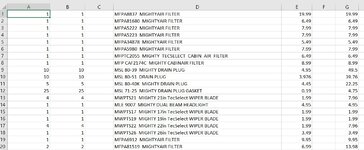BalloutMoe
Board Regular
- Joined
- Jun 4, 2021
- Messages
- 137
- Office Version
- 365
- Platform
- Windows
Hello, I have a TXT file that gets imported in excel and it always ends up in column A. I am trying to split the data up however. The middle columns with text usually vary. For example
I would like to split like this: 1.000 | 1.000 EA | rest of the text here | Then 1.9900 | 1.99. Ending up with 5 columns. However the length of the text varies every time. So if I split them normally some number won't be inline with each other. Can this be done in any specific way. Or any way to guide me get started.
| 1.000 1.000 EA MWPTS16 MIGHTY 16in TecSelect WIPER BLADE EA 1.9900 1.99 |
| 1.000 1.000 EA MWPTS18 MIGHTY 18in TecSelect WIPER BLADE EA 1.9900 1.99 |
| 1.000 1.000 EA MWPTS21 MIGHTY 21in TecSelect WIPER BLADE EA 1.9900 1.99 |
| 1.000 1.000 EA MLE 9012LL MIGHTY HIR2/12V LONG LIFE HALOGEN 16.9800 16.98 |
| EA |
| 1.000 1.000 EA MLE H11-55W MIGHTY HALOGEN HEADLAMP EA 7.9500 7.95 |
| 4.000 4.000 EA MSL 80-39 MIGHTY DRAIN PLUG EA 4.9500 19.80 |
| 1.000 1.000 EA MFPTC2064 MIGHTY TECSELECT CABIN AIR FILTER 5.4900 5.49 |
| EA |
I would like to split like this: 1.000 | 1.000 EA | rest of the text here | Then 1.9900 | 1.99. Ending up with 5 columns. However the length of the text varies every time. So if I split them normally some number won't be inline with each other. Can this be done in any specific way. Or any way to guide me get started.






